Abstract
Fabrication of high-entropy alloys (HEAs) is a crucial area of interest for materials scientists since these metallic materials may have many practical uses. Wire arc additive manufacturing (WAAM), unlike other additive technologies, has tangible benefits for making large-sized components, but manufacturing the wire from HEAs is still very limited. Recent studies suggested tackling this problem using a combined cable composed of wires consisting of pure elements as feeding material. However, not all compositions of HEAs can be obtained by the pure elements’ wires because the number of them is limited. This study aims to examine phase composition, chemical elements distribution, microstructure, and mechanical properties of a Co-Cr-Fe-Mn-Ni HEA, which was not previously obtained by the WAAM. The cable-type wire used in this study is composed of two wires which consist of Cr, Fe, Mn, and Ni, and one pure Co wire. The phase composition, chemical elements distribution, microstructure, and mechanical properties were investigated. The prepared high-entropy alloy has non-equiatomic chemical composition with a single-phase FCC crystal structure with homogeneously distributed elements inside the grains. The microstructure examinations showed dendrite structure which is typical for WAAM processes. The compressive yield strength of the alloy is ~279 MPa, the ultimate compressive strength is ~1689 MPa, the elongation is 63%, and the microhardness is ~150 HV, which was found to be similar to the previously fabricated Co-Cr-Fe-Mn-Ni alloys by other methods. Fracture analysis confirmed the ductile behavior of deformation by the presence of dimples.
1. Introduction
High-entropy alloys (HEA) are the new design concept of alloys, which consist of several principal elements (more than three) with no single dominant element, in contrast to traditional dilute alloys [1]. In addition, HEAs may also contain minor elements to modify the properties of the base HEA [2]. Such chemical composition provides unusual effects not available for the conventional alloys, composed of one or two main components and several alloying elements. These unique effects are the high entropy of mixing [3], severe lattice distortion [4], sluggish diffusion [5], and “cocktail effect” [6], which contribute to the enhancing of mechanical, corrosive, and thermal stability properties of the material.
One of the first designed HEAs is the Co-Cr-Fe-Mn-Ni system obtained by Cantor et al. [7], which showed an unexpected single-phase structure instead of a multiphase structure. According to previous results, this alloy demonstrates high corrosion resistance [8], prominent mechanical properties [9], and good weldability [10]. Since additive manufacturing technologies provide a high degree of design freedom, allowing rapid prototyping components with complex shapes with minimum cost, which are not time consuming, they can be widely used to fabricate HEAs [11]. Piglione A. et al. demonstrated good printability of the equiatomic CoCrFeMnNi by laser powder bed fusion [12]. Zhang X. et al. provided an approach of laser metal deposition of the CoCrFeMnNi HEA-based composites and observed nonporous, compact, and two-phase microstructure of FCC matrix and precipitates [13]. Binder jetting additive manufacturing was successfully applied to fabricate porous CoCrFeMnNi HEA [14]. The methods mentioned above are very accurate, but the sizes of the chamber typically limit the size of the parts that can be fabricated. Additionally, the powders used in these additive technologies are expensive, decreasing the number of possible applications of this HEA.
Recent studies showed that wire arc additive manufacturing could be adopted for the fabrication of HEAs. The advantages of this method, compared with conventional casting and other additive manufacturing technologies, are the lower cost of the initial materials and equipment, the ability to produce large-sized parts, higher deposition rates, and less ecological impact [15]. It was suggested that several stranded pure wires should be used as the feeding material [16]. By this method, Shen Q. et al. obtained Al-Co-Cr-Fe-Ni HEA, which consists of FCC and ordered BCC phases showing higher ultimate compressive stress and elongation than the casted alloy [17]. Liu J. et al. reported the WAAM Mo30.7Nb13.4Ta13.4W15.2Ti27.3 HEA, which showed a single disordered BCC solid solution phase structure with no apparent component segregation [18].
However, not all compositions of the HEAs are possible to obtain by the pure elements’ wires because their number is limited. Therefore, our previous studies suggested fabricating Al-Co-Cr-Fe-Ni non-equiatomic HEA using two wires containing Co, Cr, Fe, and Ni and a single pure Al wire [19,20]. The results illustrated that the mechanical properties of this alloy are comparable with the other Al-Co-Cr-Fe-Ni HEA systems produced by additive manufacturing. Since the Co-Cr-Fe-Mn-Ni HEA system has many potential applications such as turbine blades, liquid gas storage, nuclear constructions, etc. [21]. Where applying the wire arc additive manufacturing will reduce cost and time, the present study is devoted to fabricating the Co-Cr-Fe-Mn-Ni system by WAAM and investigating its phase composition, chemical elements distribution, microstructure, and mechanical properties.
2. Materials and Methods
Previous studies proposed several phenomenological parameters, according to which, the phase composition of the HEA in this study was predicted [21,22,23,24,25]. According to the preliminary calculated chemical composition [26] the following wires were chosen: pure Co wire (Co ≈ 99.9 at. %) ≈ 0.47 mm in diameter; Autrod 16.95 welding wire (Fe ≈ 65.3 at. %, Cr ≈ 19.6 at. %, Ni ≈ 7.3 at. %, Si ≈ 1.6 at. %, Mn ≈ 6.2 at. %) preliminarily thinned from ≈ 0.80 down to ≈ 0.74 mm in diameter; Ni80Cr20 wire (Cr ≈ 22.5 at. %, Fe ≈ 1.5 at. %, Ni ≈ 72.1 at. %, Al ≈ 0.8 at. %, Si ≈ 2.9 at. %, Mn ≈ 0.2 at. %) ≈ 0.4 mm in diameter (Figure 1a). The wires were stranded using special stranding equipment. The average diameter of the combined cable wire was ≈ 1.25 mm, lay length of the stranded wire was 10 mm (Figure 1b).
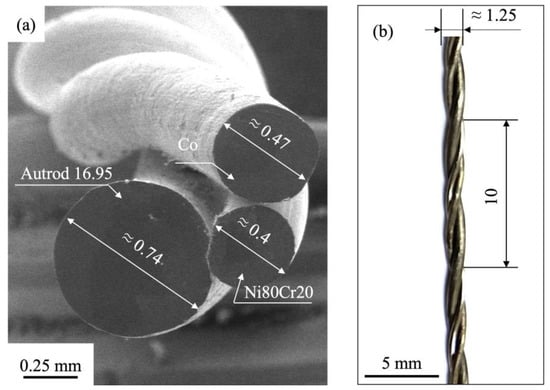
Figure 1.
(a) SEM image of the cross-section of the stranded wire, (b) macro photograph of the stranded wire.
The Co-Cr-Fe-Mn-Ni HEA was manufactured via layer-by-layer deposition using wire arc additive manufacturing (WAAM). Gas metal arc welding was adopted for this technology. The alloy was deposited on a 321 stainless steel substrate with a size of 200 × 300 × 5 mm3. The deposited sample had the size of 140 × 20 × 30 mm3 and consisted of 4 layers in width and 7 layers in height. As shielding gas was used pure argon (99.99% purity) at a constant flow rate of 15 (L/min). The deposition parameters were chosen according to the trial-and-error method until the manufactured material showed no visible defects. Based on the previous studies, which focused on the selection of appropriate processing conditions to fabricate defect-free components [27,28], we started our trials with the following parameters: wire feed speed 10 m/min, arc voltage 22 V, and torch travel speed 0.1 m/min. Arc voltage and torch travel speed were maintained, and by increasing the wire feed speed with the step 0.1 m/min, we sought the formation of a short-circuited transfer with continuous deposit. When the metal transfer reached good stability and the deposit became continuous, we stopped our trials at a wire feeding speed of 13 m/min. The distance from the torch to the deposition surface was maintained at 10 mm.
X-ray diffraction (XRD) analysis using DRON-7 (BOUREVESTNIK, JSC, Saint-Petersburg, Russia) X-ray diffractometer with Cu-Kα1 (λ = 0.15406 nm) radiation at 40 kV and 30 mA was used to identify the phase composition in the alloy. The XRD analysis was performed on polished sample surfaces, and the scans were performed over a scanning range of 20° < 2θ < 100° with a 0.02° step size and 2 s counting time.
The microstructure and chemical distribution were analyzed by optical microscope METAM PB-34 and scanning electron microscope TESCAN VEGA, equipped with an energy-dispersive spectrometer (EDS) INCAx-act. In addition, the fracture surface was studied with LEO EVO 50.
Compressive tests at 1.2 mm/min strain rates were carried out at room temperature using a universal electronic tensile testing machine. For compressive tests, 3 samples were cut from the as-deposited material alongside the direction of the layer deposition and had sizes of 9.8 × 4.8 × 4.8 mm3. Tensile tests were conducted at strain rates of 0.2 mm/min with 3 samples cut from the as-deposited material, perpendicular to the direction of the layer deposition, having sizes of 18 × 4.5 × 1 and gauge length of 8 mm. The hardness of the samples was measured using a Vickers hardness Tester HV-1000 with a load of 1 kg held for 10 s. The number of tests was not less than 10 to obtain adequate statistics.
3. Results and Discussion
Table 1 and Table 2 show the results of the preliminary calculations, which were carried out to choose the wires presented in the materials and method section. Combining the existing wires with various chemical compositions and diameters by a specially developed program, the final wires meeting the requirements of the solid solution formation of the final HEA were chosen. Table 1 contains the comparison results between the calculated and experimentally obtained compositions of the HEA fabricated via WAAM. The maximum error (88%) was revealed in calculating the impurities that wires contain, but the principal element’s chemical composition calculation accuracy was about 90%.

Table 1.
The comparison between calculated and experimentally obtained chemical compositions of the HEA fabricated via WAAM.

Table 2.
The calculated thermodynamic parameters and the prediction of the phase composition of the HEA fabricated via WAAM.
The results of the XRD analysis are displayed in Figure 2. XRD revealed that the sample has a simple FCC phase with the lattice parameter a = 0.35788 nm. A similar value of the lattice parameter was obtained in [29]. In addition, the XRD pattern shows a strong (200) peak that possibly indicates the texture of the solidification. A similar XRD pattern was obtained in in situ alloyed CoCrFeMnNi HEA fabricated by laser powder bed fusion [12]. Comparing the results of XRD analysis with the data of the prediction of the phase composition (Table 2), it could be seen that the theoretical phase composition is correlated with the experimental one.
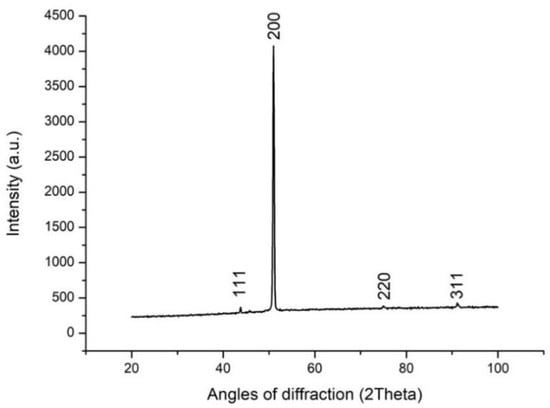
Figure 2.
The XRD analysis Co-Cr-Fe-Mn-Ni HEA sample fabricated by WAAM.
Microstructural observation of the middle part of the sample is presented in Figure 3. The optical microscopy image illustrates distinct boundaries between three layers. Layers show different directions of the dendrite grains orientation, which may be caused by the various directions of the heat propagation which occur during solidification processes. Observed dendrites have a transversal size of ~7 µm and a longitude size of ~3 mm, which is the layer’s height. Such structure could probably be formed because of the high cooling rates during wire arc additive manufacturing. A similar microstructure with the various directions of the dendrites was observed in the middle area of the AZ31 magnesium alloy investigated in [30].
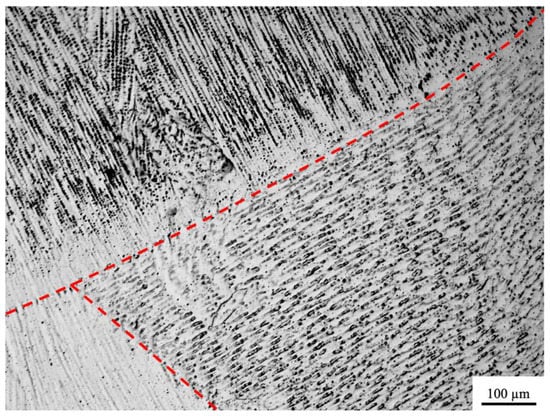
Figure 3.
Optical micrograph of the middle part of the Co-Cr-Fe-Mn-Ni HEA sample fabricated by WAAM. The dotted curves illustrate boundaries between layers.
EM mapping of the cross-section of the dendrites is presented in Figure 4. The transversal size of the dendrites is 7.7 ± 0.4 µm, which confirms the results of the optical microscopy. SEM analysis also demonstrates the presence of rounded pores (1.3 ± 0.1 µm) in the microstructure. One of the main possible reasons for the formation of the pores is the absorption of gases by the molten metal during deposition. Although shielding gas was used, some amount of oxygen, hydrogen, or nitrogen could be drawn into the welding bead. During cooling of the liquid metal, the gas is floating to the surface, but with a decrease in the temperature, the speed of the gas moving decreases, and finally, some gases are stayed in the welding bead, causing porosity [31]. Therefore, we suggest that pores could be formed in examined samples owing to the gas generation induced by chemical reactions of the liquid alloy with the environmental gases.
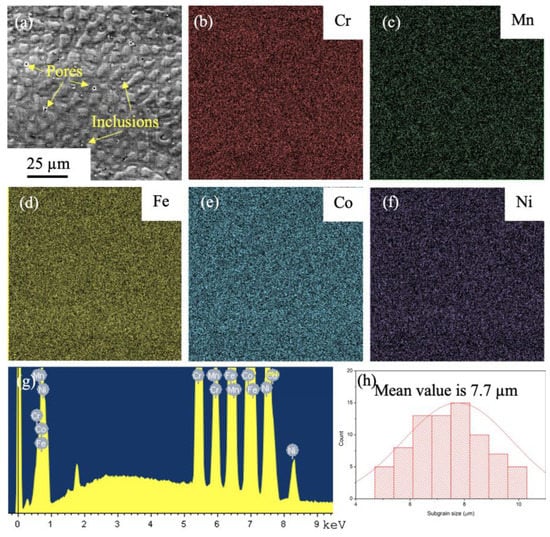
Figure 4.
(a–f) Surface EDS mapping of the dendrite cross-section structure in the Co-Cr-Fe-Mn-Ni high-entropy alloy fabricated by WAAM; (g) EDS peaks of this region; (h) dendrites’ transversal size distribution.
The chemical elements’ distribution (Figure 4) is homogeneous, demonstrating that the solid solution forms with no apparent element segregation. Nevertheless, by SEM analysis, rounded inclusions with the size of 1.9 ± 0.3 µm were found (Figure 4), and EDS mapping analysis showed that they mainly consist of Al, O, and Mn (Figure 5). The chemical composition of the inclusions is presented in Table 3. These impurities were expected to be found in the microstructure because the initial wires contained small quantities of these elements. However, since the volumetric fraction of these impurities was less than 1% according to Table 1, the corresponding XRD spectrum (Figure 2) has possibly not shown its presence. As emphasized in [29,32], non-metallic inclusions could be found even in the equiatomic FeCrNiMnCo alloys melted under vacuum or using an inert gas atmosphere. For example, Al2O3 inclusions can be formed due to the high affinity between aluminum and oxygen, which were observed in an FeCrNiMnCo alloy [33]. The Mn-, Cr-, and Al-rich oxides were also found in an FeCrNiMnCo alloy ingot produced by the vacuum induction melting process [29]. To sum up, the presence of impurities is unavoidable because the initial wires were not completely pure; furthermore, their presence can be predicted.
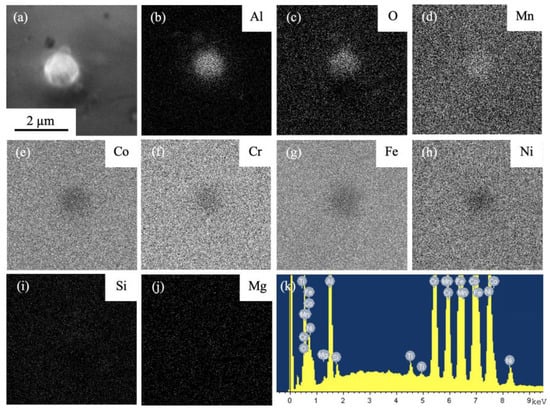
Figure 5.
(a–j) Surface EDS mapping of the inclusion in the structure of the Co-Cr-Fe-Mn-Ni HEA fabricated by WAAM; (k) represents (EDS) peaks of the inclusion.

Table 3.
Composition of inclusions in the Co-Cr-Fe-Mn-Ni HEA fabricated by WAAM.
The typical compressive and tensile stress–strain curves are shown in Figure 6a. The ultimate compressive strength of the as-built alloy is 1689 ± 343 MPa, which is higher than the ultimate tensile test 499 ± 74 MPa; whereas, yield strength showed a similar value in both types of tests. The SEM fractography of a tensile specimen is provided in Figure 6b. The presence of dimples in the microstructure indicates that the deformation occurred by the ductile mechanism, which is typical for Co-Cr-Fe-Mn-Ni system HEAs. The mechanical properties are summarized in Table 4. The results show relatively high ultimate compressive strength and moderate ultimate tensile strength compared with alloys fabricated by other methods. Strain before fracture is higher than in the Co-Cr-Fe-Mn-Ni HEAs obtained by selective laser melting (SLM) but almost the same as in the cast alloys. The average microhardness of the HEA is 153 ± 3 HV1, which is near to the as-cast equiatomic Co-Cr-Fe-Mn-Ni HEAs. Such mechanical properties might be related to FCC phase composition, which all compared materials have. Since the crystal structure is the same, plastic deformation occurs by the exact mechanism.
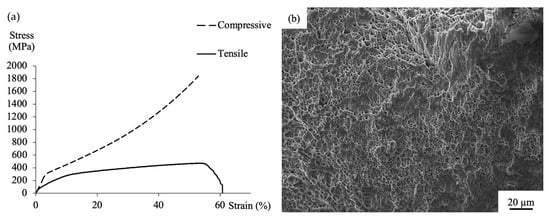
Figure 6.
(a) The representative stress–strain curves and (b) an SEM image of fracture surface of the Co-Cr-Fe-Mn-Ni HEA fabricated by WAAM.

Table 4.
The mechanical properties of wire arc additive manufactured non-equiatomic Co-Cr-Fe-Mn-Ni HEA.
The as-built WAAM non-equiatomic Co-Cr-Fe-Mn-Ni HEA showed relatively higher yield strength than the cast and LMD equiatomic Co-Cr-Fe-Mn-Ni HEAs but less than those manufactured by SLM (Table 4). The ultimate compressive strength (UCS) of the alloy obtained in this study (1689 ± 343 MPa) is about 3 times higher than that of the cast alloy, but the ultimate tensile strength (UTS) (499 ± 74 MPa) is less than that in the materials fabricated by SLM and LMD. Strain before fracture at uniaxial tensile test (63 ± 25%) is higher than in the Co-Cr-Fe-Mn-Ni HEAs obtained by selective laser melting but almost equivalent to as-cast alloys. One of the possible reasons for such values in the mechanical properties of the same HEA system, but obtained by different methods, is the different cooling rates which these techniques use. For example, cooling rates during wire arc additive manufacturing reach 100–300 K/s [28], whereas selective laser melting has cooling rates up to 106 K·s−1 [34], laser metal deposition (LMD) has cooling rates up to 104 K·s−1 [35], and arc melting cooling rates are approximately 100 K·s−1 [36]. The cooling rates influence directly upon the microstructure, and the higher the cooling rates, the less elemental segregation, and the higher density of dislocations [37], which is beneficial for the yield strength, because crystalline solids’ dominant plastic deformation mechanism is the glide of dislocations [38]. According to this, SLM and LMD must have the highest. Therefore, one of the possible ways to improve the mechanical properties of the Co-Cr-Fe-Mn-Ni HEA fabricated by WAAM is increasing cooling rates by air jet impingement [39] or by process planning strategy with controlled interlayer temperature [40], or a combination of these methods.
Another crucial factor that may have a significant effect on the mechanical properties of the alloy is the presence of volume defects as micropores and non-metallic inclusions (NMI). During the plastic deformation, pores become stress concentrators that decrease the mechanical properties, because they probably “yield first due to the reduced tensile load-bearing capacity” [41]. Complete reduction in pores can be reached by using inter-layer cold-rolling during WAAM deposition [42]. The rounded particles observed in this study are distributed in the microstructure of the alloy with the number density (ND) of 138 mm−2, which was calculated as ND = (total number of inclusions)/(observed area) (Figure 4a). Choi N. et al. reported that tensile properties of HEA, namely the yield strength and ultimate strength, can degrade as the ND of inclusions increases because NMI can initiate the nucleation of voids leading to the degradation of tensile properties [29]. Therefore, NMI revealed that the microstructure of the Co-Cr-Fe-Mn-NI HEA fabricated by WAAM might decrease the mechanical properties.
To sum up, even though the chemical composition of the Co-Cr-Fe-Mn-Ni HEA investigated in this study is non-equiatomic with the prevailing Fe and Co components and low content of Mn, the microstructure and mechanical properties of that alloy are rather similar to the equiatomic one. The presence of volume defects probably decreased the mechanical properties of the alloy by developing premature cracks. Nevertheless, this study showed the applicability of using cable-type wire composed of non-pure wires to fabricate the Co-Cr-Fe-Mn-Ni HEA system by WAAM. Future research should be focused on improving the mechanical properties of the alloy by eliminating volume defects in the microstructure.
4. Conclusions
A non-equiatomic Co-Cr-Fe-Mn-Ni high-entropy alloy was successfully fabricated by wire arc additive manufacturing, using cable-type wire composed of one pure Co wire and two Cr-, Fe-, Mn-, and Ni-containing wires as feeding material. The phase composition, chemical elements distribution, microstructure, and mechanical properties of the as-deposited alloy was analyzed. The following conclusions could be drawn from the obtained results:
- Preliminary calculations conducted in this study had an error of not more than 10% for predicting the chemical composition of the principal elements, which confirms the possibility of fabricating HEAs from non-pure wires by wire arc additive manufacturing.
- X-ray diffraction analysis demonstrated that the fabricated Co-Cr-Fe-Mn-Ni HEA showed a single FCC solid solution phase with homogeneous element distribution that correlated with the preliminary calculations of the phase composition.
- Optical microscopy showed that the samples’ layers were composed of dendrite grains with a transversal size of 7.7 ± 0.4 µm. These dendrites were oriented along with the cooling directions, most likely because of the high cooling rates typical for WAAM.
- Scanning electron microscopy revealed the presence of defects, such as rounded non-metallic inclusions and micropores. The inclusions contained mostly Al, O, and Mn and had sizes of 1.9 ± 0.3 µm. They were allocated in the microstructure with the number density of 138 mm−2. The pores had the size of 1.9 ± 0.3 µm and were probably formed owing to the gas generation induced by chemical reactions.
- The mechanical tests showed that the as-built alloy has relatively high yield strength ~279 MPa, compared with alloys fabricated by arc melting and laser metal deposition techniques, but lower than the values of the CoCrFeMnNi alloys fabricated by selective laser melting. The ultimate tensile strength (499 ± 74 MPa) is less compared with alloys fabricated by SLM and LMD. Strain before fracture (~63%) is higher than in the CoCrFeMnNi HEAs obtained by selective laser melting, but almost equivalent to as-cast alloys. The average microhardness of the HEA is 153 ± 3 HV1.
- The mechanical properties of the obtained as-deposited HEA showed higher yield strength than the cast and LMD CoCrFeMnNi HEAs, but less than those manufactured by SLM.
This study confirms that the non-equiatomic Co-Cr-Fe-Mn-Ni HEA, fabricated by WAAM, using cable-type wire composed of non-pure wires, demonstrated good mechanical properties, even though it revealed the presence of volume defects as micropores and non-metallic inclusions. Future research will tackle these problems by using additional post-deposition treatment.
Author Contributions
Conceptualization, S.K. and Y.I.; methodology, S.K. and V.G.; formal analysis, Y.I., S.K., D.Z. and I.P.; investigation, S.K., Y.I. and K.O.; resources, S.K. and V.G.; writing—original draft preparation, S.K., K.O. and Y.I.; writing—review and editing, S.K., Y.I., V.G., K.O. and I.P.; supervision, V.G.; project administration, S.K. and V.G.; funding acquisition, V.G. All authors have read and agreed to the published version of the manuscript.
Funding
This research was funded by Russian Science Foundation (project 20-19-00452).
Institutional Review Board Statement
Not applicable.
Informed Consent Statement
Not applicable.
Data Availability Statement
Not applicable.
Acknowledgments
The TEM investigations were carried out using the equipment at the Share Use Centre “Nanotech” of the Institute of Strength Physics and Materials Science SB RAS, Tomsk, Russia.
Conflicts of Interest
The authors declare no conflict of interest.
References
- Miracle, D.B. High entropy alloys as a bold step forward in alloy development. Nat. Commun. 2019, 10, 1805. [Google Scholar] [CrossRef]
- Yeh, J.-W. Recent progress in high-entropy alloys. Ann. Chim. Sci. Des Mater. 2006, 31, 633–648. [Google Scholar] [CrossRef]
- Yeh, J.W.; Chen, S.K.; Lin, S.J.; Gan, J.Y.; Chin, T.S.; Shun, T.T.; Tsau, C.H.; Chang, S.Y. Nanostructured high-entropy alloys with multiple principal elements: Novel alloy design concepts and outcomes. Adv. Eng. Mater. 2004, 6, 299–303. [Google Scholar] [CrossRef]
- Yeh, J.-W.; Chen, S.-K.; Gan, J.-Y.; Lin, S.-J.; Chin, T.-S.; Shun, T.-T.; Tsau, C.-H.; Chang, S.-Y. Formation of simple crystal structures in Cu-Co-Ni-Cr-Al-Fe-Ti-V alloys with multiprincipal metallic elements. Metall. Mater. Trans. A Phys. Metall. Mater. Sci. 2004, 35, 2533–2536. [Google Scholar] [CrossRef]
- Tsai, K.-Y.; Tsai, M.-H.; Yeh, J.-W. Sluggish diffusion in Co–Cr–Fe–Mn–Ni high-entropy alloys. Acta Mater. 2013, 61, 4887–4897. [Google Scholar] [CrossRef]
- Saito, T. Multifunctional Alloys Obtained via a Dislocation-Free Plastic Deformation Mechanism. Science 2003, 300, 464–467. [Google Scholar] [CrossRef] [PubMed] [Green Version]
- Cantor, B.; Chang, I.T.H.; Knight, P.; Vincent, A.J.B. Microstructural development in equiatomic multicomponent alloys. Mater. Sci. Eng. A 2004, 375–377, 213–218. [Google Scholar] [CrossRef]
- Xu, Z.; Zhang, H.; Du, X.; He, Y.; Luo, H.; Song, G.; Mao, L.; Zhou, T.; Wang, L. Corrosion resistance enhancement of CoCrFeMnNi high-entropy alloy fabricated by additive manufacturing. Corros. Sci. 2020, 177, 108954. [Google Scholar] [CrossRef]
- Picak, S.; Yilmaz, H.C.; Karaman, I. Simultaneous deformation twinning and martensitic transformation in CoCrFeMnNi high entropy alloy at high temperatures. Scr. Mater. 2021, 202, 113995. [Google Scholar] [CrossRef]
- Wu, Z.; David, S.A.; Leonard, D.N.; Feng, Z.; Bei, H. Microstructures and mechanical properties of a welded CoCrFeMnNi high-entropy alloy. Sci. Technol. Weld. Join. 2018, 23, 585–595. [Google Scholar] [CrossRef]
- Khorasani, M.; Ghasemi, A.; Rolfe, B.; Gibson, I. Additive manufacturing a powerful tool for the aerospace industry. Rapid Prototyp. J. 2021, 28, 87–100. [Google Scholar] [CrossRef]
- Chen, P.; Yang, C.; Li, S.; Attallah, M.M.; Yan, M. In-situ alloyed, oxide-dispersion-strengthened CoCrFeMnNi high entropy alloy fabricated via laser powder bed fusion. Mater. Des. 2020, 194, 108966. [Google Scholar] [CrossRef]
- Zhang, X.; Li, R.; Huang, L.; Amar, A.; Wu, C.; Le, G.; Liu, X.; Guan, D.; Yang, G.; Li, J. Influence of in-situ and ex-situ precipitations on microstructure and mechanical properties of additive manufacturing CoCrFeMnNi high-entropy alloys. Vacuum 2021, 187, 110111. [Google Scholar] [CrossRef]
- Xu, Z.; Zhu, Z.; Wang, P.; Meenashisundaram, G.K.; Nai, S.M.L.; Wei, J. Fabrication of porous CoCrFeMnNi high entropy alloy using binder jetting additive manufacturing. Addit. Manuf. 2020, 35, 101441. [Google Scholar] [CrossRef]
- Lockett, H.; Ding, J.; Williams, S.; Martina, F. Design for wire + Arc additive manufacture: Design rules and build orientation selection. J. Eng. Des. 2017, 28, 568–598. [Google Scholar] [CrossRef] [Green Version]
- Li, J.L.Z.; Alkahari, M.R.; Rosli, N.A.B.; Hasan, R.; Sudin, M.N.; Ramli, F.R. Review of wire arc additive manufacturing for 3d metal printing. Int. J. Autom. Technol. 2019, 13, 346–353. [Google Scholar] [CrossRef]
- Shen, Q.; Kong, X.; Chen, X. Fabrication of bulk Al-Co-Cr-Fe-Ni high-entropy alloy using combined cable wire arc additive manufacturing (CCW-AAM): Microstructure and mechanical properties. J. Mater. Sci. Technol. 2021, 74, 136–142. [Google Scholar] [CrossRef]
- Liu, J.; Li, J.; Du, X.; Tong, Y.; Wang, R.; He, D.; Cai, Z.; Wang, H. Microstructure and mechanical properties of wire arc additively manufactured monbtawti high entropy alloys. Materials 2021, 14, 4512. [Google Scholar] [CrossRef]
- Osintsev, K.; Konovalov, S.; Gromov, V.; Panchenko, I.; Ivanov, Y. Microstructural and mechanical characterisation of non-equiatomic Al 2.1 Co 0.3 Cr 0.5 FeNi 2.1 high-entropy alloy fabricated via wire-arc additive manufacturing. Philos. Mag. Lett. 2021, 101, 353–359. [Google Scholar] [CrossRef]
- Osintsev, K.A.; Konovalov, S.V.; Glezer, A.M.; Gromov, V.E.; Ivanov, Y.F.; Panchenko, I.A.; Sundeev, R.V. Research on the structure of Al2.1Co0.3Cr0.5FeNi2.1 high-entropy alloy at submicro- and nano-scale levels. Mater. Lett. 2021, 294, 129717. [Google Scholar] [CrossRef]
- Zhang, Y.; Zhou, Y.J.; Lin, J.P.; Chen, G.L.; Liaw, P.K. Solid-solution phase formation rules for multi-component alloys. Adv. Eng. Mater. 2008, 10, 534–538. [Google Scholar] [CrossRef]
- Yang, X.; Zhang, Y. Prediction of high-entropy stabilized solid-solution in multi-component alloys. Mater. Chem. Phys. 2012, 132, 233–238. [Google Scholar] [CrossRef]
- Takeuchi, A.; Inoue, A. Classification of Bulk Metallic Glasses by Atomic Size Difference, Heat of Mixing and Period of Constituent Elements and Its Application to Characterization of the Main Alloying Element. J. Postgrad. Med. Inst. 2016, 30, 80–83. [Google Scholar] [CrossRef] [Green Version]
- Fang, S.; Xiao, X.; Xia, L.; Li, W.; Dong, Y. Relationship between the widths of supercooled liquid regions and bond parameters of Mg-based bulk metallic glasses. J. Non-Cryst. Solids 2003, 321, 120–125. [Google Scholar] [CrossRef]
- Guo, S.; Liu, C.T. Phase stability in high entropy alloys: Formation of solid-solution phase or amorphous phase. Prog. Nat. Sci. Mater. Int. 2011, 21, 433–446. [Google Scholar] [CrossRef] [Green Version]
- Gromov, V.E.; Konovalov, S.V.; Ivanov, Y.F.; Osintsev, K.A. Prediction of Phase Composition of Al-Co-Cr-Fe-Ni System High-Entropy Alloy; Springer International Publishing: Cham, Switzerland, 2021; Volume 107. [Google Scholar]
- Gomez Ortega, A.; Corona Galvan, L.; Deschaux-Beaume, F.; Mezrag, B.; Rouquette, S. Effect of process parameters on the quality of aluminium alloy Al5Si deposits in wire and arc additive manufacturing using a cold metal transfer process. Sci. Technol. Weld. Join. 2018, 23, 316–332. [Google Scholar] [CrossRef] [Green Version]
- Ou, W.; Mukherjee, T.; Knapp, G.L.; Wei, Y.; DebRoy, T. Fusion zone geometries, cooling rates and solidification parameters during wire arc additive manufacturing. Int. J. Heat Mass Transf. 2018, 127, 1084–1094. [Google Scholar] [CrossRef]
- Choi, N.; Lim, K.R.; Na, Y.S.; Glatzel, U.; Park, J.H. Characterization of non-metallic inclusions and their influence on the mechanical properties of a FCC single-phase high-entropy alloy. J. Alloys Compd. 2018, 763, 546–557. [Google Scholar] [CrossRef]
- Yang, X.; Liu, J.; Wang, Z.; Lin, X.; Liu, F.; Huang, W.; Liang, E. Microstructure and mechanical properties of wire and arc additive manufactured AZ31 magnesium alloy using cold metal transfer process. Mater. Sci. Eng. A 2020, 774, 138942. [Google Scholar] [CrossRef]
- Wahab, M.A. Manual Metal Arc Welding and Gas Metal Arc Welding. In Comprehensive Materials Processing; Elsevier: Amsterdam, The Netherlands, 2014; Volume 6, pp. 49–76. ISBN 9780080965338. [Google Scholar]
- Choi, N.; Park, N.; Kim, J.; Karasev, A.V.; Jönsson, P.G.; Park, J.H. Influence of Manufacturing Conditions on Inclusion Characteristics and Mechanical Properties of FeCrNiMnCo Alloy. Metals 2020, 10, 1286. [Google Scholar] [CrossRef]
- Licavoli, J.J.; Gao, M.C.; Sears, J.S.; Jablonski, P.D.; Hawk, J.A. Microstructure and Mechanical Behavior of High-Entropy Alloys. J. Mater. Eng. Perform. 2015, 24, 3685–3698. [Google Scholar] [CrossRef] [Green Version]
- Zhang, C.; Zhu, J.; Zheng, H.; Li, H.; Liu, S.; Cheng, G.J. A review on microstructures and properties of high entropy alloys manufactured by selective laser melting. Int. J. Extrem. Manuf. 2020, 2, 032003. [Google Scholar] [CrossRef]
- Zhong, M.; Liu, W. Laser surface cladding: The state of the art and challenges. Proc. Inst. Mech. Eng. Part C J. Mech. Eng. Sci. 2010, 224, 1041–1060. [Google Scholar] [CrossRef]
- Ma, L.; Li, C.; Jiang, Y.; Zhou, J.; Wang, L.; Wang, F.; Cao, T.; Xue, Y. Cooling rate-dependent microstructure and mechanical properties of Al Si0.2CrFeCoNiCu1−x high entropy alloys. J. Alloys Compd. 2017, 694, 61–67. [Google Scholar] [CrossRef]
- Otto, F.; Dlouhý, A.; Somsen, C.; Bei, H.; Eggeler, G.; George, E.P. The influences of temperature and microstructure on the tensile properties of a CoCrFeMnNi high-entropy alloy. Acta Mater. 2013, 61, 5743–5755. [Google Scholar] [CrossRef] [Green Version]
- Mittemeijer, E.J. Fundamentals of Materials Science; Springer: Berlin/Heidelberg, Germany, 2011; ISBN 978-3-642-10499-2. [Google Scholar]
- Hackenhaar, W.; Mazzaferro, J.A.E.; Montevecchi, F.; Campatelli, G. An experimental-numerical study of active cooling in wire arc additive manufacturing. J. Manuf. Process. 2020, 52, 58–65. [Google Scholar] [CrossRef]
- Zhao, Y.; Jia, Y.; Chen, S.; Shi, J.; Li, F. Process planning strategy for wire-arc additive manufacturing: Thermal behavior considerations. Addit. Manuf. 2020, 32, 100935. [Google Scholar] [CrossRef]
- Fang, X.; Zhang, L.; Li, H.; Li, C.; Huang, K.; Lu, B. Microstructure Evolution and Mechanical Behavior of 2219 Aluminum Alloys Additively Fabricated by the Cold Metal Transfer Process. Materials 2018, 11, 812. [Google Scholar] [CrossRef] [Green Version]
- Gu, J.; Ding, J.; Williams, S.W.; Gu, H.; Ma, P.; Zhai, Y. The effect of inter-layer cold working and post-deposition heat treatment on porosity in additively manufactured aluminum alloys. J. Mater. Process. Technol. 2016, 230, 26–34. [Google Scholar] [CrossRef]
- He, J.Y.; Liu, W.H.; Wang, H.; Wu, Y.; Liu, X.J.; Nieh, T.G.; Lu, Z.P. Effects of Al addition on structural evolution and tensile properties of the FeCoNiCrMn high-entropy alloy system. Acta Mater. 2014, 62, 105–113. [Google Scholar] [CrossRef]
- Stepanov, N.D.; Shaysultanov, D.G.; Salishchev, G.A.; Tikhonovsky, M.A.; Oleynik, E.E.; Tortika, A.S.; Senkov, O.N. Effect of V content on microstructure and mechanical properties of the CoCrFeMnNiVx high entropy alloys. J. Alloys Compd. 2015, 628, 170–185. [Google Scholar] [CrossRef]
- Li, B.; Zhang, L.; Xu, Y.; Liu, Z.; Qian, B.; Xuan, F. Selective laser melting of CoCrFeNiMn high entropy alloy powder modified with nano-TiN particles for additive manufacturing and strength enhancement: Process, particle behavior and effects. Powder Technol. 2020, 360, 509–521. [Google Scholar] [CrossRef]
Publisher’s Note: MDPI stays neutral with regard to jurisdictional claims in published maps and institutional affiliations. |
© 2022 by the authors. Licensee MDPI, Basel, Switzerland. This article is an open access article distributed under the terms and conditions of the Creative Commons Attribution (CC BY) license (https://creativecommons.org/licenses/by/4.0/).